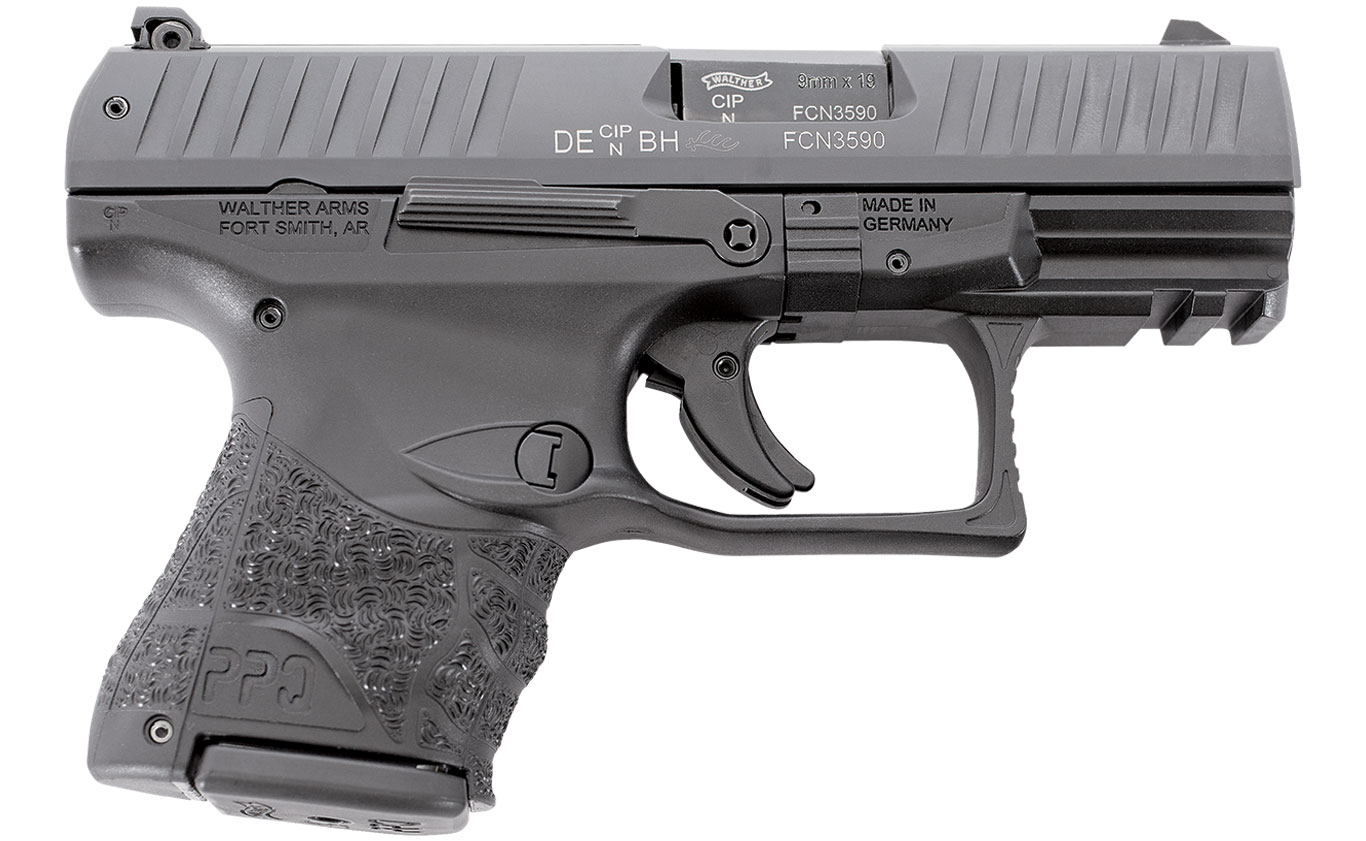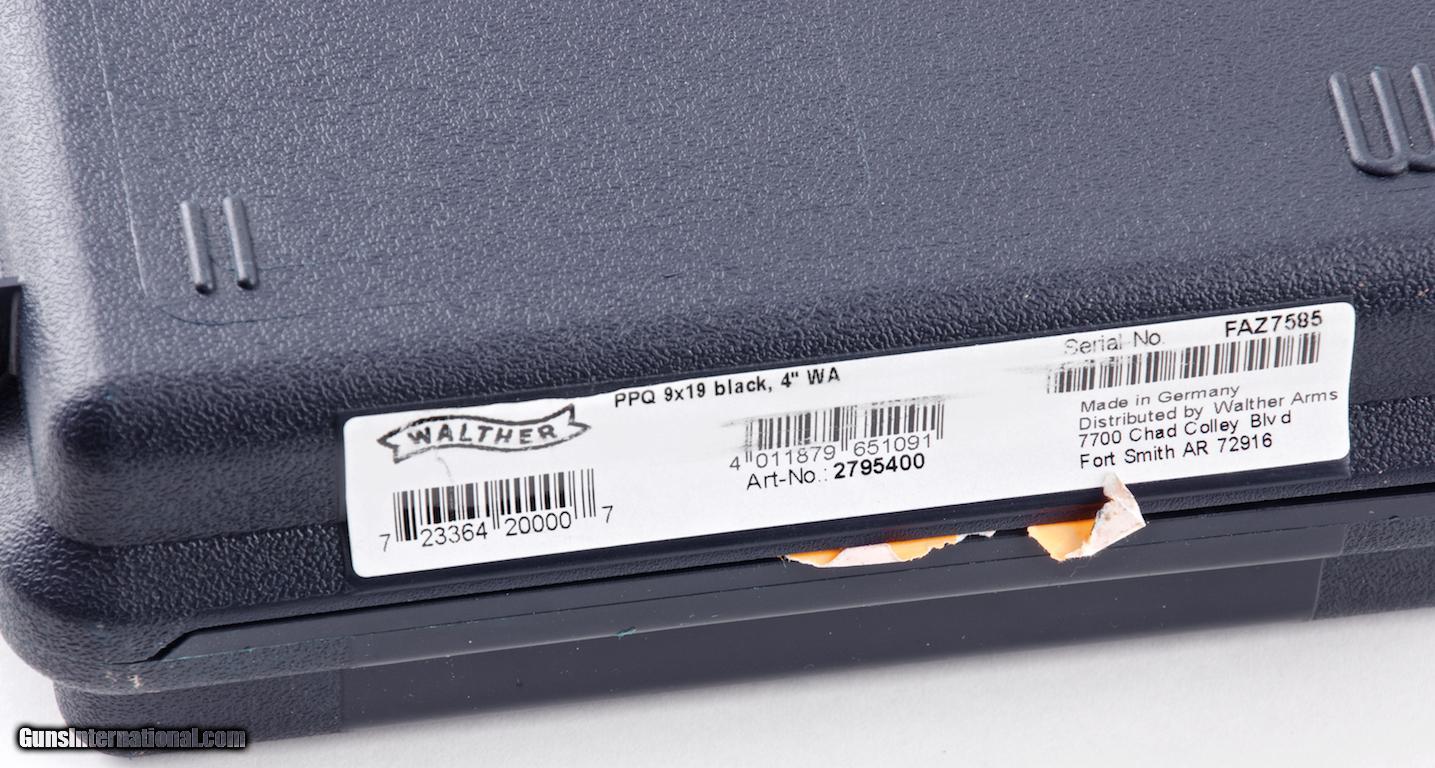Model PPQ Navy Model PPQ SC Model PPQ M2 Q4 TAC Q4 Steel Frame PPQ.45 PPQ M2 Q5 Match PPQ M2 Q5 Match Steel Frame Model PPX CCP M2 WALTHER POST-WORLD WAR II Model PP—Some with Duraluminum Frames Model PP—All Three Calibers Finished In Blue, Silver and Gold with Full. The Walther PPQ (German:, Polizeipistole Quick Defence / Police Pistol Quick Defence) is a semi-automatic pistol developed by the German company Carl Walther GmbH Sportwaffen of Ulm for law enforcement, security forces and the civilian shooting market as a potential replacement for the Walther P99. Walther once again took the industry by storm with the introduction of the first polymer frame semi-auto rimfire pistol, the P22. The consistent reliability, timeless style, features, and outright affordability pushed this series to become the absolute standard.

PPQ 278 44 67 9mm x 19, 9mm x 21,.40 S&W Rev. 277 64 72; 277 64 81; 278 33 55; 278 33 63; 278 33 80; 278 33 98; 278 61 09; 278 71 05; 278 78 90; 279 51 41; 279 54 00; 279 54 18; 279 96 00 Legende: AFC Anti Friction Coating ET Ersatzteil mit Waffennummer / spare part with serial number. Walther PPQ Duty Series grip package. 360 degree removal of factory texture to establish uniform surface; mild trigger guard bevel and mag release fence bevel and polish for improved ergonomics; 360 degree grip texture; trigger guard flat textured; all texture framed in with our distinct sculpted hand-cut edge lines.
Walther’s new PPQ Sub Compact packs a lot into a small package.
After spending time shooting the PPQ SC (Sub Compact), I find it a lot like a medium-size Labrador: stoutly built, tough and ready for anything—and of the firm opinion that it is a big dog.
The Sub Compact has all the attributes of the new Walther PPQ line. The slide is contoured for ease of grasping to actuate it. The slide serrations are angled so they will dig into your hands as you work the slide. The pyramidal shape of the slide acts to give the slide the maximum purchase on your fingers and the heel of your hand.

The PPQ SC barrel is Tenifer-treated, as is the slide, and features the pistol’s serial number, caliber and German proof, as well as the Walther logo. Up on top of the chamber is a viewing port that serves as a loaded-chamber indicator. The serial number and proof continue onto the slide and the frame. (An interesting sidenote: The serial numbers are applied via laser after the pistols are assembled, inspected and test-fired.)
The barrel geometry is efficient in locking the barrel to the slide, and as a result the force needed to retract the slide is not nearly as great as I’d have expected for a subcompact pistol. Usually, the recoil spring has to be beefed up so much to deal with the lighter slide that getting a round chambered can be an ordeal—especially for those who might have decreased hand strength. With the PPQ SC, the slide effort feels the same as a full-size pistol.
The ejection port is a huge exit portal for empty brass or, should the need arise, to clear out a loaded round. At no time during testing did I have even the slightest hint that the brass was having trouble getting gone. After a couple of range sessions, I usually find brass marks on the slide in the area of the ejection port, which indicates that the empties had to ricochet off the slide, or tarried in the near vicinity, before leaving. Not so with the PPQ Sub Compact. Even after sending a bunch of ammo downrange, there were no brass marks on the slide.
Walther uses the same slide for both 9mm and .40, changing only barrel, extractor and breechface adapter to the appropriate caliber.
Inside the slide, the PPQ uses a striker system, and when I took it apart (which is easy to do), I found the breechface had an extractor and a breechface adapter, both marked “9mm.” The clever Walther engineers designed the slide to work with either 9mm or .40 S&W, and assemblers simply use the appropriate extractor and adapter.
Disassembly is easy. Unload the pistol. Lock back the slide. Remove the magazine. Pull down both sides of the disassembly block at the same time. Once the block clicks down, ease the slide forward. Once it stops, dry-fire the pistol, and the slide then can come off the frame.
The recoil spring is a self-contained dual-spring system, and it simply clicks into a semicircular recess on the bottom of the barrel. Once you have the spring and barrel out of the slide, you can clean everything. With the barrel and spring are back in the slide, run the assembled slide back onto the frame. Lock it to the rear. Press the disassembly block up until it clicks and you’re done.
With the 10-round magazine in place, there’s not much room to get all your fingers on the gun, but the serrations on the grip do a good job of helping with control.

The standard version of the PPQ SC comes with a compact, 10-round magazine (10 rounds because it is compact, not because of legal restrictions) with flat baseplate and a special 15-round PPQ magazine. This full-capacity magazine has a sleeve that fills the gap between the baseplate and the frame. This makes it feel like you’re holding a full-size frame, and it also prevents over-insertion of the longer magazine. This Sub Compact-marked magazine also has a stronger spring than a regular 15-round magazine to ensure it keeps up with the faster cycling time of the shorter Sub Compact slide.
Would the SC stumble if you used regular PPQ magazines? My sample didn’t when I tried it, but I was very careful not to over-insert the mags—which risks whacking them into the ejector, possibly bending or even breaking this essential part. In other words, if you want a full-capacity magazine in your Sub Compact, use the one that comes with the pistol.
Like the other PPQ M2 pistols, the Sub Compact has a button mag release instead of the paddle on the M1. The Quick Defense trigger has a nice pull and a very short reset.
The PPQ SC features an ambidextrous slide lever and a reversible magazine button. It’s the same mag release found on the PPQ M2, not the dual-paddle release found on the M1. This is America, after all, and we know where we expect the magazine release to be. The frame features an accessory rail.
Naturally, the Sub Compact features an accessory rail for lights and lasers.
The Quick Defense trigger is equipped with a blocking lever to prevent it from pivoting unless your finger is pressing it. It has a very short reset, for those who fuss over such things. It is also linked to the striker system in the slide, which has both a striker-blocking safety and a pair of drop safeties. The trigger pull on the PPQ Sub Compact is as nice as the trigger on the full-size PPQ M2 sitting in my safe. Just because it is a compact carry gun doesn’t mean it can’t have a nice trigger pull.
Below that, the frame is sculpted with the same curves as the full-sized PPQ, but it stops shorter. The frame is only long enough for me to get two fingers on it, and my last finger either has to float in air or to curl up underneath the magazine baseplate. This can make shooting a bit more work than it needs be.

My Sub Compact sample was the law enforcement version, which comes with a third 10-round magazine featuring a finger extension that makes the gun a little more controllable.
The gun features three-dot sights, with the rear sight adjustable for elevation. The rear sight rests in a dovetail, so you can drift it for windage adjustments. My only complaint is the sights are made of polymer. For most uses—in fact, for the great majority of uses—this is not a problem. They are durable and stand up to solvents and cleaning brushes. However, polymer sights can wear down after thousands of draws from Kydex holsters. Time will tell, and it may be that the Walther slide contour protects the sights. And, truth be told, how many CCW gun owners subject their guns to thousands of draws? That’s usually the province of competition shooters.
In testing, the small grip and the light weight of the Sub Compact made a difference. I happened to be shooting another 9mm pistol, one with more than twice the starting weight, and the recoil differences were noticeable.
Not that the PPQ Sub Compact was obnoxious to shoot. Far from it. It was just more vigorous in its recoil than the all-steel near-anvil I was also shooting. The frame’s multidirectional pattern of small, ranked crescents keep the PPQ Sub Compact firmly in your hand, regardless of the direction recoil wants to take it.
The vigorous recoil did not keep the PPQ Sub Compact from printing tight groups. It was just a bit less forgiving than if it had been a bigger pistol. It also proved reliable—even after I accidentally dumped it in the sand at my range while setting up my gear. The PPQ Sub Compact shrugged it off and worked just fine.

With the right holster, the Walther PPQ Sub Compact will ride unnoticed on your belt—and unnoticed by your back, kidneys and waistline. It will not be weighty enough to cause you to list to one side, and should you need it, the Quick Defense trigger means you can focus on the sights—and the need to shoot or not—and not how you’re going to be struggling through the trigger pull. And you’ll be able to take full advantage of the Walther accuracy built into each PPQ, whether full size or Sub Compact.
Source link
- Ammo Type:Centrefire
- Action Type:Semi Automatic
- Bore Diameter:0.355
- Calibre:9x19mm Parabellum
- Serial Number:FCC7647
Private User
| Seller Type: | Private User Licence # 555-270-10H |
|---|---|
| Location: | SOUTH DUDLEY, VIC, 3995 |
| Phone #: | *** click to reveal *** |
| Transferring Dealer: | Russell James Cargill , QLD, 4012 Licence # 40745390F |
| View other listings from this seller | |
Description:
In excellent condition. Comes with all original manuals, tools, fittings, extras, etc. Brand new Vortex Viper Red Dot Scope, After market progressive recoil spring assembly. Price includes postage wthin Australia and dealer transfer fee my end. This pistol has only fired 400 rounds. Selling due to not required any more.
Date Listed: 08/05/2020